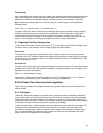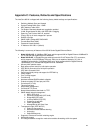37
Chapter 6 Switching Concepts
The following sections provide brief explanations of some of the concepts related to switching. If more
information is required, please refer to networking textbooks, online resources (i.e. www.oreillynet.com) or
your MIS manager.
6.1 Spanning Tree Protocol
The Spanning Tree Protocol (STP) is part of the IEEE 802.1D standard. It provides for a redundant network
without the redundant traffic through closed paths. For example, in a network without spanning tree protocol,
the same message will be broadcast through multiple paths, which may start an unending packet-passing
cycle. This in turn causes a great amount of extra network traffic, leading to network downtime. The STP
reduces a network like this, with multiple, redundant connections, to one in which all points are connected,
but where there is only one path between any two points (the connections span the entire network, and the
paths are branched, like a tree).
6.1.1 How It Works
All of the bridges (a switch is a complex bridge) on the network communicate with each other using special
packets of data called Bridge Protocol Data Units (BPDUs). The information exchanged in the BPDUs allows
the bridges on the network to do the following:
• Elect a single bridge to be the root bridge
• Calculate the shortest path from each bridge to the root bridge
• Select a designated bridge on each segment, which lies closest to the root and forwards all traffic
to it
• Select a port on each bridge to forward traffic to the root
• Select the ports on each bridge that forward traffic, and place the redundant ports in blocking states
6.1.2 Spanning Tree Parameters
The operation of the spanning tree algorithm is governed by several parameters. You should attempt to set
these parameters only if you have experience with the 802.1D specification. To set the parameters listed
below, access the Spanning Tree/Bridge Settings screen (console or telnet), or the Spanning Tree/Bridge
Settings page (in the web interface).
Bridge Priority
Setting the Bridge Priority to a low value will increase the likelihood that the current bridge will become the
root bridge. If the current bridge is located physically near the center of your network, you may wish to
decrease the Bridge Priority from its default value of 32768 to make it become the root bridge. If the current
bridge is near the edge of your network, it is best to leave the value of the Bridge Priority at its default
setting.
Hello Time
This is the time period between BPDUs transmitted by each bridge. The default setting is 2 seconds.
Maximum Age
Each bridge should receive regular configuration BPDUs from the direction of the root bridge. If the
maximum age timer expires before the bridge receives another BPDU, it assumes that a change in the
topology has occurred, and it begins recalculating the spanning tree. The default setting for Maximum Age is
20 seconds.


















